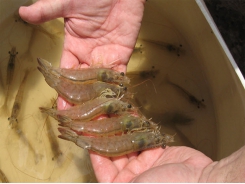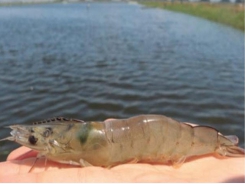Understanding shrimp hemocytes Part 1

An important mechanism of defense against viruses, bacteria and other pathogens
Shrimp producers seeking to improve the profitability of their crops must be aware of external factors that may affect the survival and growth of their shrimp. One of the limiting factors for success in shrimp farming is the control of diseases. This control is mainly based on biosecurity, good nutrition and reduction of stress conditions during cultivation.
In this sense, the study of the immune system of marine shrimp stands out as a source of knowledge to determine the degree of the animal’s susceptibility and resistance to pathogenic microorganisms and parasites. In addition, these studies provide valuable knowledge to the relationship between the physical-chemical parameters of water and the degree of immune response.
The shrimp’s mechanisms of defense that allow the control of attacks by external agents such as viruses and bacteria include the production of hemocytes, defense cells present in the blood of shrimp. This is the central theme of this article, adapted and summarized from the original publication in Revista Acuacultura – National Chamber of Aquaculture, No. 126, December 2018.

The process of melanization (dark spots on shrimp shell, top) by the prophenoloxidase (ProPO) system is a major, innate defense system in invertebrates. After invading microbes are encapsulated or phagocytosed, the process of melanization (involving granular hemocytes) helps expel these pathogens by cuticular excretion or during the next molting cycle (center), supporting a healthy animal (bottom).
1/ Hemocytes: Cells to fight pathogens
White shrimp, like other invertebrate animals, depend on their immune system to protect themselves from diseases in situations where some microbe or foreign particle invades their tissues. This immunological reaction is manifested through cellular mechanisms where hemocytes play a very important role.
The blood of shrimp – or hemolymph – has a cellular component, which is the hemocytes, and a liquid component constituted of plasma that contains different humoral factors (macromolecules of the circulatory system). The immune-cellular and humoral responses act in an integrated manner creating defense mechanisms such as the coagulation of hemolymph; melanization by the prophenoloxidase (ProPO) system – a major, innate defense system in invertebrates; use of lectins for the recognition of foreign agents; and antibacterial, antifungal and antiviral peptide systems that act with interference RNA and a pattern of recognition proteins. We can also add the production of reactive forms of oxygen, phagocytosis and encapsulation, the latter two mainly performed by hemocytes (Iwanaga & Lee, 2005).
- Hemocytes (Fig. 1) are produced in the hematopoietic tissues of shrimp, and there are two types:
- Hyaline hemocytes that absorb pathogens or foreign particles through the process of phagocytosis. They also intervene in the coagulation process.
Granular hemocytes or granulocytes that – through encapsulation, nodule formation and cytotoxicity – destroy invading elements. They also intervene in melanization (ProPO system).

Fig. 1: Types of hemocytes (hyaline and granular) produced by the Pacific white shrimp (Litopenaeus vannamei) to combat pathogens and foreign particles that invade their tissues. Photo by Carlos Ching.
The hyaline hemocytes initiate the defense in the face of an injury with the coagulation process, a critical mechanism that protects the shrimp from an excessive loss of liquids as well as to capture and immobilize invading microbes. Next, the granular hemocytes secrete defensive enzymes that kill the microbes before being eliminated by other granulocytes through the processes of phagocytosis and/or encapsulation. Once the microbes are encapsulated or phagocytosed, the process of melanization, which is also led by the granular hemocytes, leaves them inert and prepares them to be expelled by the cuticular excretion or during the next molting cycle.
The hemocyte defense mechanism also causes the increase of cells with free radicals and stimulate the hyaline hemocytes to become granular hemocytes, increasing in this way the rate of elimination of pathogens by the degranulation process (Fig. 2).

Fig. 2: Illustration of the mechanisms of an immune reaction in which hemocytes intervene when pathogens enter the shrimp tissues (Jiravanichpaisal et al., 2006).
2/ Water quality and its effect on hemocyte production
The production of hemocytes as a response to disease attacks is closely linked to the physical-chemical parameters of water, such as temperature, oxygen, pH and salinity, as we will see below.
Relationship temperature – hemocytes during a white spot virus attack
Experiments on the effect of temperature on shrimp infected with the white spot virus (WSSV) have shown that higher production of hemocytes occurs at higher temperatures (Sonnenholzner et al., 2002). Animals infected with WSSV achieved 100 percent survival when cultured at 33 degrees-C, while those cultured at 27 degrees-C only achieved 10 percent survival. This was due to the fact that, at 33 degrees-C, the production of hemocytes is greater (Fig. 3).

Fig. 3: Total hemocyte count/ml in hemolymph of L. vannamei juveniles infected orally with WSSV in water of 33 degrees-C and 27 degrees-C for eight days (Sonnenholzner et al., 2002).
Another study that must be considered is the one by Wongmanneeprateep et al. (2010), which maintained juvenile shrimp infected with white spot at a constant temperature of 32 ± 1 degrees-C for seven consecutive days, thus eliminating WSSV infection. This study served as the basis for testing raceways where larvae infected with WSSV were cleaned after seven days at temperatures of 32 ± 1 degrees-C (Limsuwan, 2015, Fig. 4).

Fig. 4: Treatment to clean the L. vannamei postlarvae infected with WSSV in raceways. The temperature was maintained at 32 ± 1 degrees-C for seven days. This treatment has been replicated from mysis to the juvenile stage (Limsuwan, 2015).
On the other hand, it must be considered that there is a risk in elevating the temperature above 30 degrees-C, as the populations of Vibrio bacteria can be increased (Chen et al., 2005), in which case the larvae can be dosed with shrimp health diets such as Nicovita Origin (composed of organic acids that produce a bactericidal effect on vibrios) and water bioremediation to control bacterial populations.
Related news
Tools

Phối trộn thức ăn chăn nuôi

Pha dung dịch thủy canh

Định mức cho tôm ăn

Phối trộn phân bón NPK

Xác định tỷ lệ tôm sống

Chuyển đổi đơn vị phân bón

Xác định công suất sục khí

Chuyển đổi đơn vị tôm

Tính diện tích nhà kính

Tính thể tích ao




 Understanding shrimp hemocytes Part 2
Understanding shrimp hemocytes Part 2  Use algorithms to calculate feed for Pacific white…
Use algorithms to calculate feed for Pacific white…